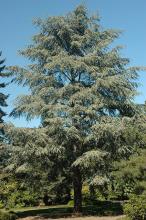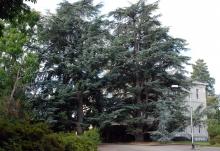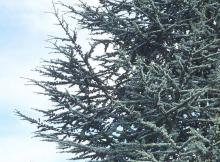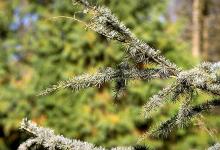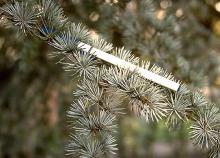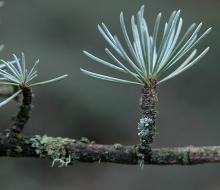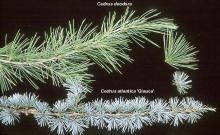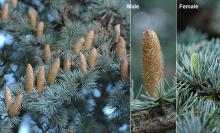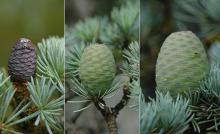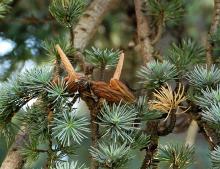Cedrus atlantica 'Glauca'
Common name:
Blue Atlas Cedar
Pronunciation:
SE-drus at-LAN-ti-ka
Family:
Pinaceae
Genus:
Synonyms:
C. atlantica (Glauca Group)
C. libani subsp. atlantica 'Glauca'
Type:
Conifer
Native to (or naturalized in) Oregon:
No
- Conifer, evergreen, 40-60(120) ft [12-18(40) m] tall, stiff, erect leader, pyramidal in youth, with age assumes a flat-topped habit with ascending or horizontal branches. Branch tips tend not to droop. Twigs spreading, stout, finely hairy. Bluish-green needles clustered (10-20) on spurs, or alternate on leading twigs, about 2 cm long, somewhat stiff. Male (pollen) cones are about 5 cm long, erect, they release clouds of yellow pollen in the fall. Female (seed) cones are barrel-shaped, upright, 5-7.5 cm long, and require 2 years to mature.
- Sun or partial shade. Prefers moist, well-drained, deep loamy soil, but tolerates clay soils. Protect for sweeping winds.
- Hardy to USDA Zone 6 (not hardy for much of the US) Species native to the Atlas Mountains of Algeria and Morocco. Blue forms ('Glauca') are selected from seedling populations, so it is sometimes listed as C. atlantica f. glauca, or C. atlantica var. glauca.
- A popular weeping "blue" form is 'Glauca Pendula'.
- The Cedrus genus was formerly considered to include four species, but it has been reduced to two, C. deodara of the Himalayas and C. libani (Cedar of Lebanon) of the Mediterranean. C. atlantica, the most common species used in landscaping is now considered to be a subspecies of C. libani (i.e., C. libani ssp. atlantica), or even just synonymous (van Gelderen and van Hoey Smith, 1996). Hence the glauca form may be named C. libani ssp. atlantica 'Glauca' or possibly even C. libani 'Glauca'. However, it is likely that C. atlantica will continue to be sold under that name for some time. Some have championed the idea of Cedrus atlanica (Glauca Group) as an attempts to deal with the variety in needle color by lumping all of the various blue-needled plants into a single group.
- Oregon State Univ. campus: two large trees southeast of Gilmore.

